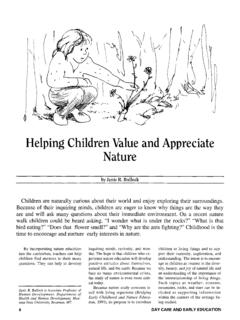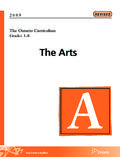Transcription of Helping children value and appreciate nature
1 \. ~d Helping children value and appreciate nature by Janis R. Bullock children are naturally curious about their world and enjoy exploring their surroundings. Because of their inquiring minds, children are eager to know why things are the way they are and will ask many questions about their immediate environment. On a recent nature walk children could be heard asking, "I wonder what is under the rocks?" "What is that bird eating?" "Does that flower smell?" and "Why are the ants fighting?" Childhood is the time to encourage and nurture early interests in nature . By incorporating nature education inquiring minds, curiosity, and won- children to living things and to sup- into the curriculum, teachers can help der. The hope is that children who ex- port their curiosity, exploration, and children find answers to their many perience nature education will develop understanding.
2 The intent is to encour- questions. They can help to develop positive attitudes about themselves, age in children an interest in the diver- natural life, and the earth. Because we sity, beauty, and joy of natural life and face so many environmental crises, an understanding of the importance of the study of nature is even more criti- the interrelationship of living things. cal today. Such topics as weather, streams, Because nature study concerns it- mountains, rocks, and stars can be in- Janis R. Bullock is Associate Professor of Human Development, Department of self with living organisms (Bridging cluded as supporting i n f o r m a t i o n Health and Human Development, Mon- Early Childhood and nature Educa- within the context of the settings be- tana State University, Bozeman, MT. tion, 1991), its purpose is to introduce ing studied. 4 DAY CARE AND EARLY EDUCATION. What Is the value of nature quires that teachers think about what it who feel less confident can begin by Education?
3 Is that they want children to learn exploring their own uneasiness about (Hendrick, 1990). nature . Becoming more knowledge- Early childhood educators and nat- Some goals for nature education able about a topic will build confi- uralists (Bridging Early Childhood are: dence. Teachers can consult curricu- and nature Education, 1991) have 9 to develop respect for and appre- lum books on the importance of nature identified five areas that support the ciation of all forms of nature education to the developing child (see value of nature education in the devel- 9 to understand the relationships " C u r r i c u l u m R e s o u r c e s " ) , discuss opment of young children : between habitats and humans ideas with staff, and make contact 1. nature education provides an 9 to learn facts that can be used for with resource people in agencies or important foundation of experiences thinking and reasoning skills universities, if available.
4 Teachers can and assists children in making sense 9 to become observers of the envi- spend time listening and talking to of their world. In order to develop an ronment children regarding their interests. appreciation of nature children need to 9 to use the senses to learn about What do children bring with them, engage in many repeated and varied the environment think about, explore, and question? opportunities over periods of time all 9 to learn about new interests and Teachers can let the parents know that year long. They need time to experi- areas in the child's immediate envi- they are looking for ideas and re- ence, explore, and process information ronment sources. I have found that many par- in order to get beyond surface-level 9 to ask questions, to explore, to ents have a strong interest in nature - understanding. discover, and to have fun related issues and are very willing to 2.
5 Exploring nature provides chil- 9 to appreciate the beauty found in share their knowledge and resources dren with m a n y opportunities that nature with children . transcend language and race. All chil- 9 to learn to overcome any fears Although less experienced teachers dren can come to appreciate the beau- that may have been acquired will need to work at developing re- ty, wonder, and common experiences 9 to learn to be cautious about na- sources and curriculum activities, they provided by nature . Regardless of the ture when necessary. do not need to be experts in all areas area in which children live, they can of nature education or think that they learn about events relevant to their What Can Teachers Do? should have all of the answers to chil- surroundings. It is well known that young chil- dren' s questions. The process of learn- 3. Experiences with nature can pro- dren learn best by interacting directly ing begins when a teacher might say, vide the realAife context for children 's with their environment through rele- " I ' m not sure of the answer, but let's books as well as for other activities.
6 Vant, concrete hands-on experiences, see what we can do to find out." This children 's books and classroom activ- and by having rich opportunities to a p p r o a c h can build c o n f i d e n c e in ities often focus on household pets, play ( B r e d e k a m p , 1987; B y b e e & teachers when they discover the mutu- farm animals, and animals in the wild. Sund, 1982). As teachers o b s e r v e al j o y of l e a r n i n g with children . Experiences with nature can help to y o u n g children e n g a g i n g in these Teachers need to take time to experi- reinforce concepts of great interest to processes, they realize that much of ence the natural world, to build confi- children and can broaden the context what attracts children 's attention is dence, and to trust in themselves. of their learning. their immediate natural world. From Using the immediate environment 4. Experiences with nature can h e ~ smelling a flower, touching a worm, as a base, teachers can begin by devel- to stimulate children 's own natural cu- tasting a wild berry, hearing the birds oping activities that are related to chil- riosity about their world.
7 Sing, and seeing a butterfly, to feeling dren's lives. Animal and plant life can 5. Experiences with nature can help the wind and rain, children use all of be brought into the classroom, where children to develop a respect for living their senses to learn about nature . The children can take part in their care. things. children who come to appreci- concept of personal ecology defined One child brought in some tadpoles ate living things and understand the by Holt (1989) as "the individual child that he had caught in a nearby pond, importance of the relationships among interrelating, interweaving, and inter- and the children b e c a m e v e r y in- them will be less likely to hurt or de- acting with the phenomena that make volved in observing their transition stroy them. up his own environment" (p. 118) pro- into frogs. The children cared for and vides an appropriate guide to the study fed the tadpoles and discussed the What Are Some Goals of nature of nature .
8 This idea places children at changes in their appearance. Stories Education? the center of their learning and daily and pictures about tadpoles and frogs When planning nature experiences reality. were placed near the aquarium. To teachers need to ask themselves some In order for nature education to be m a k e a c o n n e c t i o n to the natural fundamental questions. What are my meaningful, children need to believe world, we p l a n n e d a field trip to goals? What do I hope the children that their teachers value nature . Chil- release the frogs back into the pond. will gain from the experience? How dren need to sense the excitement and Other children became very interested will the experience cover several areas curiosity about and the awe of nature in the water, and they brought some of the curriculum? Selecting some that their teachers feel. Because teach- back to school in buckets, where they broad goals is necessary because it re- ers' attitudes are so important, those observed plant growth and bugs.
9 Still S U M M E R 1994 5. some herbs inside and talked about how they are used in cooking and eventually used them in some of our c o o k i n g p r o j e c t s . W e used s o m e weeds and flowers brought in by a parent for art collages and for pressing into clay. In addition, I brought in sev- eral potted plants and flowers that some of the children took an interest in watering and incorporating into their "house play.". As the children began to develop more of an interest in nature educa- i 1L tion, we decided to explore the area surrounding our school, which was lo- cated in a large city. We took many walking trips, and the children and I. were surprised to "discover" flowers, lots of weeds in the dirt and in cracks '! of the sidewalks, butterflies, bugs in // standing water, bees, ants, worms, and spiders. As a result, a child brought his terrarium to school to share with the children ; it contained his special bugs and some plants.
10 I invited an en- tomologist (a person who studies in- sects) to talk to the children about his work. He brought in a collection of bugs and talked about some of their characteristics, similarities, and differ- ences. He donated his collection to the school, and many children continued to enjoy looking at the bugs through magnifying glasses. My goal was to show the children that nature can be found and appreciated in large urban areas. By using all of their senses, the children were encouraged to observe, explore, question, and respect nature in their immediate environment. When I m o v e d to a rural school other children delighted in turning thread. She talked about how fabric is setting, I took time to learn about the over rocks and logs to discover what made from silk cocoons and encour- area and the interests of the children . might be underneath. aged the children to touch the fabric.



